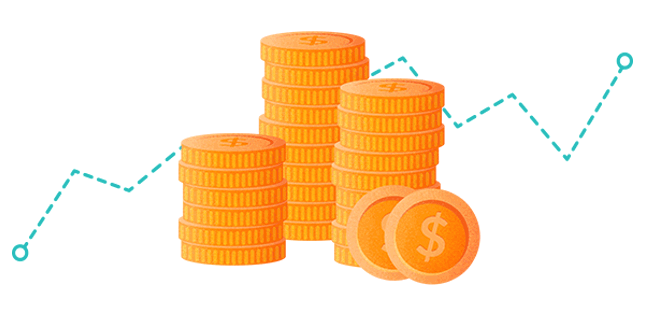Qualified Dividends
What are dividends and how can they impact taxes?
When a corporation earns a profit, it can choose to distribute a portion of this profit as dividends – as returns or rewards for its shareholders. While regular dividends are paid out periodically or on pre-set dates, companies can also pay out special dividends when they have earned high profits. Dividends are classified into qualified dividends and unqualified dividends, or ordinary dividends. Dividends are most commonly paid out in cash, but they can be in stocks or another type of property.
Dividends can help you grow your investment income. Qualified dividends and ordinary dividends have different holding periods requirement for taxes and different dividend tax rates, which can affect your tax rate. It is important to know the difference in dividends, so that you know how to minimize taxes.
What are qualified dividends?
Qualified dividends are paid by domestic and qualified foreign corporations during a tax year. They are subject to the maximum tax rates of 0%, 15%, or 20% that apply for long term capital gains. Qualified dividend tax rates for individuals, trusts, and estates are at 15%.
For those individuals with an income tax rate of 10% or 15%, capital gains tax becomes zero. These are shown on your Form 1099-DIV. Regular dividends paid to shareholders are usually qualified dividends and are subject to the lower capital gain taxes while ordinary dividends are taxed at the higher regular ordinary income tax rate.

Holding period requirement
To enjoy the lower tax rate for the qualified dividends, investors need to meet a minimum holding period rule by the IRS. The amount of time differs for the type of stock you hold.
For common stocks, the shares must be held for more than 60 days during a 121-day period that begins 60 days before the ex-dividend date. This is the first date which the stock price does not include the upcoming dividend payment. In order to receive the upcoming dividend, the holder has to own the shares before the ex-dividend date. The minimum 60-day holding period rule also applies to mutual funds.
For preferred stocks, the shares have to be held for over 90 days during a 181-day period that begins 90 days before the ex-dividend date.
What are Ordinary Dividends?
The most common form of distribution by a company or a mutual fund is an ordinary dividend. Regular dividends are generally classified as such unless the corporation or mutual fund company states otherwise.
According to FINRA and S&P Dow Jones, about 84% of large-cap companies in the S&P 500 index pay dividends compared to around 70% and 54% for the mid-cap and small-cap companies. The S&P 500 dividend yield most recent data was at 1.9%. If you want to search internationally, the Euro Stoxx 600 in Europe offers an enticing 3.7% dividend yield.
When a company has excess profits that they want to distribute to their shareholders, the company’s board of directors “declare” a dividend, and the company will announce the amount and the date that the regular dividends will be paid out during earnings calls or press releases. Companies usually set a dividend policy to pay out their cash over time. Apart from regular dividends, companies can also pay out special dividends, which are usually a one-time payment.
As they are paid out from the company’s profits or earnings, ordinary dividends have different dividend tax rates than qualified dividends. These dividends are taxed as investment income at the ordinary income tax rate and not at capital gains, which are the profits earned when you purchase an investment at a lower price than you sell.
Regular dividends as investment strategy
In the low-return world today, investors have been hungry for investments that can give them a steady or growing cashflow. High regular dividend-paying stocks, in addition to fixed income, are important additions to a well-balanced portfolio. Apart from the traditional high yielding stocks in the utilities, telecoms, or consumer staples sector, you can spot higher dividend-paying stocks in the technology and financial sectors as well as real estate investment trusts and master limited partnerships. Not all dividends are created equal, and preferably, you want to find investments that will pay out qualified dividends, which will enjoy a lower dividend tax rate.
Requirements for Qualified Dividends
To be classified as qualified dividends and be taxed at a lower dividend tax rate, they must satisfy certain requirements:
- Paid by domestic corporations or qualified foreign companies that trade on the U.S. stock exchanges or are incorporated in a U.S. possession.
- Must be ordinary dividends and are not capital gains distributions or dividends from tax-exempt entities.
- Met the minimum holding period requirement: more than 60 days during the 121-day period starting 60 days prior to the ex-dividend date for common stocks and more than 90 days during the 181-day period starting 90 days before the ex-dividend date for preferred stocks.
Ordinary vs. Qualified Dividends
If the above criteria are not met, then the dividends become unqualified, and unqualified dividends are taxed at the higher ordinary income tax rate rather than the lower dividend tax rate for qualified dividends.
Qualified Dividend Tax Rate
The IRS classifies capital gains into short-term for assets that are held less than one year and long term for assets that are held over a year. Given the different holding periods, short-term capital gains are treated as ordinary income while long term gains are taxed at a lower preferential rate.
Qualified dividends and sale of certain assets that are held over a year qualify for long term capital gains tax rate and are taxed at 0%, 15%, or 20% based on your income bracket and filing status. If your income is below the threshold for taxes, you pay zero. Tax-efficient strategies when selling securities can also be used to optimize taxes.
This tax rule does not apply to assets such as collectibles, art, precious metals, jewelry, antiques, and other items. They are taxed at the ordinary income tax rate depending on your tax bracket, subject to a cap of 28%. The other exception is real estate and deduction. Investors can deduct depreciation on their property from their taxes over time, thus reducing the home purchase price. When the property is sold, that depreciated amount is treated as recapture and will be taxed at 25% while the rest of the gain will be taxed at 0%, 15%, or 20%.
Capital Gains Tax Calculations
There are four steps to calculate your capital gains taxes:
- Pick out the investments and positions that have capital gains or losses.
- Determine whether the gains and losses are short-term or long-term.
- Come up with a net gain or loss for short-term and long-term. Calculate the overall net figure if you have a gain in one and a loss in the other. If both categories are gains, keep them separate.
- Apply the appropriate tax rate including the net investment income tax rate to the final results.
Certain net investment income of individuals, estates, and trusts with income above the legal threshold will incur the Net Investment Income Tax rate of 3.8%.

Unqualified Dividends
Dividends that do not qualify as qualified dividends include the following:
- Real estate investment trusts
- Master limited partnerships
- Dividends paid on employee stock options or savings or money market accounts
- Dividends paid by tax-exempt organizations
Unqualified dividends are taxed at the ordinary income rate for your tax bracket and are higher than the dividend tax rate for qualified dividends.
Tax Brackets and Tax Rates
The U.S. tax system is a progressive one, and the IRS adjusts the tax brackets for each filing category by inflation each year. The adjusted gross income (AGI) tax brackets and various tax rates for 2019 including qualified dividends tax rate are as follows:
| Ordinary income and dividend tax rate | Single | Married filing jointly | Heads of household |
|---|---|---|---|
| 10% | from $0 to $9,700 | from $0 to $19,400 | from $0 to $13,850 |
| 12% | from $9,701 to $39,475 | from $19,401 to $78,950 | from $13,851 to $52,850 |
| 22% | from $39,476 to $84,200 | from $78,951 to $168,400 | from $52,851 to $84,200 |
| 24% | from $84,201 to $160,725 | from $168,401 to $321,450 | from $84,201 to $160,700 |
| 35% | from $204,101 to $510,300 | from $408,201 to $612,350 | from $204,101 to $510,300 |
| 37% | over $510,300 | over $612,350 | over $510,300 |
Reporting Dividends
All dividend income, whether qualified dividends or not, is taxable and needs to be reported on your tax return. Your stock brokers will send you the year-end 1099-DIV, if you have dividends totaling $10 or more from any entity, specifying which dividends belong to ordinary or qualified. If you have an ownership in a partnership or S corporation, dividends will be reported on your Schedule K1.
Reducing Taxes on Qualified Dividends
There are many ways to reduce your taxes for qualified dividends and other long-term investments. Some of the strategies involve financial planning and timing, where possible. Seek the assistance of tax professionals to help in maximizing tax benefits and clarifying IRS rules. Here are some examples of ways to help minimize taxes:
- Take the time to plan the sale of your investment well as you do not need to incur taxes until you sell.
- Try to retain your investments for over a year unless the fundamentals for that investment have clearly deteriorated.
- Be aware of dividends that do not qualify and of your qualified dividends tax rate bracket.
- Offset your capital losses against gains before year-end which is also known as tax loss harvesting.
- Consider your taxable income level before you sell any winning investments so that you can enjoy the lowest tax rates possible.
- Put your investments in tax-deferred investment accounts such as IRAs and 401(k) plans and in tax-free accounts such as a Roth IRA or Roth 401 (k).

Built-in tax efficiency with M1
M1 maximizes the wealth-building potential of your dividends by allowing you to reinvest automatically, so cash always goes to work rather than sitting idly in your account. The platform provides winning investment tools that enable your money to grow automatically while minimizing your tax burden, which includes optimizing your qualified dividends tax rate.
Save more with M1. The free automated brokerage platform was created to make investing more accessible, convenient, and personalized for you. Transfer stocks and your IRA accounts seamlessly to M1 at no costs. With no commissions or management fees, you never have to worry about hidden fees eating into your returns again
With M1, you can either customize your portfolio or choose from over 80 model portfolios that are tailored to your risk tolerance, time horizons, and financial goals. The platform allows you to invest and manage your portfolio for free so that your investment dollars have the advantage to grow quicker. Through dynamic rebalancing and automatic reinvestment using award-winning investment tools and digital technology, your portfolio is by design aligned with your financial goals. Let M1 empower you to grow your investments with ease.
Tax and Legal Advice Disclaimer. M1 Finance and its affiliates do not provide tax, legal or accounting advice. This material has been prepared for informational purposes only, and is not intended to provide, and should not be relied on for, tax, legal or accounting advice.
